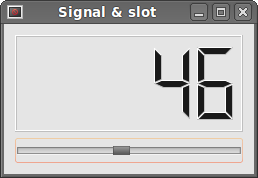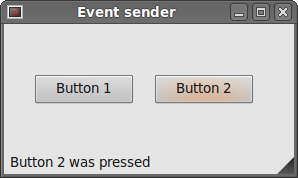[Repost]Events and Signals in PyQt4
Reference:http://zetcode.com/gui/pyqt4/eventsandsignals/
Events and Signals in PyQt4
In this part of the PyQt4 programming tutorial, we will explore events and signals occurring in applications.
Events
All GUI applications are event-driven. Events are generated mainly by the user of an application. But they can be generated by other means as well: e.g. an Internet connection, a window manager, or a timer. When we call the application's exec_() method, the application enters the main loop. The main loop fetches events and sends them to the objects.
In the event model, there are three participants:
- event source
- event object
- event target
The event source is the object whose state changes. It generates events. The event object (event) encapsulates the state changes in the event source. The event target is the object that wants to be notified. Event source object delegates the task of handling an event to the event target.
PyQt4 has a unique signal and slot mechanism to deal with events. Signals and slots are used for communication between objects. A signal is emitted when a particular event occurs. A slot can be any Python callable. A slot is called when a signal connected to it is emitted.
New API
PyQt4.5 introduced a new style API for working with signals and slots.
QtCore.QObject.connect(button, QtCore.SIGNAL('clicked()'), self.onClicked)
This is the old style API.
button.clicked.connect(self.onClicked)
The new style adheres more to the Python standards.
Signals & Slots
This is a simple example demonstrating signals and slots in PyQt4.
#!/usr/bin/python
# -*- coding: utf-8 -*- """
ZetCode PyQt4 tutorial In this example, we connect a signal
of a QtGui.QSlider to a slot
of a QtGui.QLCDNumber. author: Jan Bodnar
website: zetcode.com
last edited: October 2011
""" import sys
from PyQt4 import QtGui, QtCore class Example(QtGui.QWidget): def __init__(self):
super(Example, self).__init__() self.initUI() def initUI(self): lcd = QtGui.QLCDNumber(self)
sld = QtGui.QSlider(QtCore.Qt.Horizontal, self) vbox = QtGui.QVBoxLayout()
vbox.addWidget(lcd)
vbox.addWidget(sld) self.setLayout(vbox)
sld.valueChanged.connect(lcd.display) self.setGeometry(300, 300, 250, 150)
self.setWindowTitle('Signal & slot')
self.show() def main(): app = QtGui.QApplication(sys.argv)
ex = Example()
sys.exit(app.exec_()) if __name__ == '__main__':
main()
In our example, we display a QtGui.QLCDNumber and a QtGui.QSlider. We change the lcd number by dragging the slider knob.
sld.valueChanged.connect(lcd.display)
Here we connect a valueChanged signal of the slider to the display slot of the lcd number.
The sender is an object that sends a signal. The receiver is the object that receives the signal. Theslot is the method that reacts to the signal.
 Figure: Signal & slot
Figure: Signal & slot
Reimplementing event handler
Events in PyQt4 are processed often by reimplementing event handlers.
#!/usr/bin/python
# -*- coding: utf-8 -*- """
ZetCode PyQt4 tutorial In this example, we reimplement an
event handler. author: Jan Bodnar
website: zetcode.com
last edited: October 2011
""" import sys
from PyQt4 import QtGui, QtCore class Example(QtGui.QWidget): def __init__(self):
super(Example, self).__init__() self.initUI() def initUI(self): self.setGeometry(300, 300, 250, 150)
self.setWindowTitle('Event handler')
self.show() def keyPressEvent(self, e): if e.key() == QtCore.Qt.Key_Escape:
self.close() def main(): app = QtGui.QApplication(sys.argv)
ex = Example()
sys.exit(app.exec_()) if __name__ == '__main__':
main()
In our example, we reimplement the keyPressEvent() event handler.
def keyPressEvent(self, e):
if e.key() == QtCore.Qt.Key_Escape:
self.close()
If we click the Escape button, the application terminates.
Event sender
Sometimes it is convenient to know which widget is the sender of a signal. For this, PyQt4 has thesender() method.
#!/usr/bin/python
# -*- coding: utf-8 -*- """
ZetCode PyQt4 tutorial In this example, we determine the event sender
object. author: Jan Bodnar
website: zetcode.com
last edited: October 2011
""" import sys
from PyQt4 import QtGui, QtCore class Example(QtGui.QMainWindow): def __init__(self):
super(Example, self).__init__() self.initUI() def initUI(self): btn1 = QtGui.QPushButton("Button 1", self)
btn1.move(30, 50) btn2 = QtGui.QPushButton("Button 2", self)
btn2.move(150, 50) btn1.clicked.connect(self.buttonClicked)
btn2.clicked.connect(self.buttonClicked) self.statusBar() self.setGeometry(300, 300, 290, 150)
self.setWindowTitle('Event sender')
self.show() def buttonClicked(self): sender = self.sender()
self.statusBar().showMessage(sender.text() + ' was pressed') def main(): app = QtGui.QApplication(sys.argv)
ex = Example()
sys.exit(app.exec_()) if __name__ == '__main__':
main()
We have two buttons in our example. In the buttonClicked() method we determine which button we have clicked by calling the sender() method.
btn1.clicked.connect(self.buttonClicked)
btn2.clicked.connect(self.buttonClicked)
Both buttons are connected to the same slot.
def buttonClicked(self):
sender = self.sender()
self.statusBar().showMessage(sender.text() + ' was pressed')
We determine the signal source by calling the sender() method. In the statusbar of the application, we show the label of the button being pressed.
 Figure: Event sender
Figure: Event sender
Emitting signals
Objects created from a QtCore.QObject can emit signals. In the following example we will see how we can emit custom signals.
#!/usr/bin/python
# -*- coding: utf-8 -*- """
ZetCode PyQt4 tutorial In this example, we show how to emit a
signal. author: Jan Bodnar
website: zetcode.com
last edited: January 2015
""" import sys
from PyQt4 import QtGui, QtCore class Communicate(QtCore.QObject): closeApp = QtCore.pyqtSignal() class Example(QtGui.QMainWindow): def __init__(self):
super(Example, self).__init__() self.initUI() def initUI(self): self.c = Communicate()
self.c.closeApp.connect(self.close) self.setGeometry(300, 300, 290, 150)
self.setWindowTitle('Emit signal')
self.show() def mousePressEvent(self, event): self.c.closeApp.emit() def main(): app = QtGui.QApplication(sys.argv)
ex = Example()
sys.exit(app.exec_()) if __name__ == '__main__':
main()
We create a new signal called closeApp. This signal is emitted during a mouse press event. The signal is connected to the close() slot of the QtGui.QMainWindow.
class Communicate(QtCore.QObject):
closeApp = QtCore.pyqtSignal()
A signal is created with the QtCore.pyqtSignal() as a class attribute of the external Communicate class.
self.c.closeApp.connect(self.close)
The custom closeApp signal is connected to the close() slot of the QtGui.QMainWindow.
def mousePressEvent(self, event):
self.c.closeApp.emit()
When we click on the window with a mouse pointer, the closeApp signal is emitted. The application terminates.
In this part of the PyQt4 tutorial, we have covered signals and slots.
[Repost]Events and Signals in PyQt4的更多相关文章
- PyQt4入门
PyQt4入门教程(6)_对话框 文中译者的话将用方括号[]标出.对话框(Dialogs)是现代GUI程序中不可缺少的一部分.对话本来指的是两个或者更多人之间的交流,而在计算机应用中,对话是一个可以让 ...
- pyqt4_应用例子(计算器,对话框,进度条,日历等等)
sklearn实战-乳腺癌细胞数据挖掘(博客主亲自录制视频教程) https://study.163.com/course/introduction.htm?courseId=1005269003&a ...
- [wxWidgets] 2. 重访“Hello World” 程序
这是四年多来在博客园的第二篇博客.有了上一次的排版使用经验,这一篇文章应该有些进步(^_^). 闲话按下不表,言归正传.在编译.成功运行了上一个helloWorld.cpp(后文中'hw'简称hell ...
- STM32定时器级联 -- AN2592
Master configuration When a timer is selected as a master timer, the corresponding trigger output si ...
- API Design Principles -- QT Project
[the original link] One of Qt’s most reputed merits is its consistent, easy-to-learn, powerfulAPI. T ...
- Signal Handling--ref
http://www.chemie.fu-berlin.de/chemnet/use/info/libc/libc_21.html A signal is a software interrupt d ...
- Reactor Pattern and Non-blocking IO--reference
reference from:http://www.cs.bgu.ac.il/~spl051/Personal_material/Practical_sessions/Ps_12/ps12.html ...
- [转]使用gdb调试异常
有时程序中有未捕获的异常会导致程序异常的行为甚至导致程序的直接退出. 这对服务器程序来说是不可接受的. 可以使用gdb的catch命令来帮助我们调试异常. 使用gdb捕获异常的扔出点(相当于在扔出异常 ...
- ZetCode PyQt4 tutorial signals and slots
#!/usr/bin/python # -*- coding: utf-8 -*- """ ZetCode PyQt4 tutorial In this example, ...
随机推荐
- Redis模式匹配删除key
Redis keys命令支持模式匹配,但是del命令不支持模式匹配,有时候需要根据一定的模式来模糊删除key,这时只能结合shell命令来完成了. 具体命令是: redis-cli KEYS &quo ...
- poj 2724 Purifying Machinef
poj 2724 Purifying Machinef 题意 每一个01串中最多含有一个'*','*'既可表示0也可表示1,给出一些等长的这样的01串,问最少能用多少个这样的串表示出这些串.如:000 ...
- Kafka实战-Flume到Kafka
1.概述 前面给大家介绍了整个Kafka项目的开发流程,今天给大家分享Kafka如何获取数据源,即Kafka生产数据.下面是今天要分享的目录: 数据来源 Flume到Kafka 数据源加载 预览 下面 ...
- 一个ERP项目实施工程师的若干体会
本人在多年的工作中,参与了ERP的研发和实施,对ERP有较深的认识.在这里,根据自已的实施过程中的一些经历,把自已在实践中的一些体会贡献出来和大家共享,由于时间和精力所限,内容难免有不当之处,挂一漏万 ...
- C++ 11 中的右值引用
C++ 11 中的右值引用 右值引用的功能 首先,我并不介绍什么是右值引用,而是以一个例子里来介绍一下右值引用的功能: #include <iostream> #include &l ...
- 淘宝分布式NOSQL框架:Tair
Tair 分布式K-V存储方案 tair 是淘宝的一个开源项目,它是一个分布式的key/value结构数据的解决方案. 作为一个分布式系统,Tair由一个中心控制节点(config server)和一 ...
- UITableView的添加、删除、移动操作
#pragma mark -----表视图的移动操作----- //移动的第一步也是需要将表视图的编辑状态打开 //2.指定哪些行可以进行移动 - (BOOL)tableView:(UITableVi ...
- [nosql之缓存memcache]安装篇LInux for Windows
首先呢在PHP开发的过程中会用到很多缓存服务,从而提升访问质量或者临时存储一些数据. 优点 结构简单,读取速度快,易于维护.还有一些特性memcache redis mongodb都可以用来做为缓存用 ...
- 汤森路透为何一定要卖掉SCI?
http://health.sohu.com/20160714/n459331727.shtml
- tyvj1863 [Poetize I]黑魔法师之门
背景 经过了16个工作日的紧张忙碌,未来的人类终于收集到了足够的能源.然而在与Violet星球的战争中,由于Z副官的愚蠢,地球的领袖applepi被邪恶的黑魔法师Vani囚禁在了Violet星球.为了 ...
